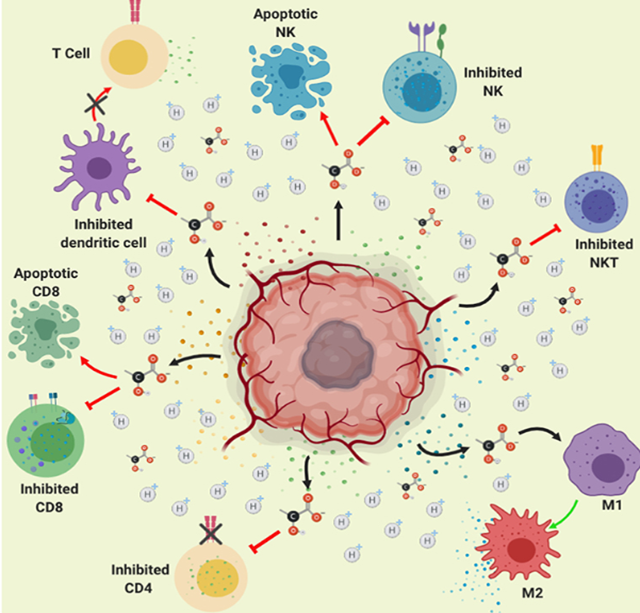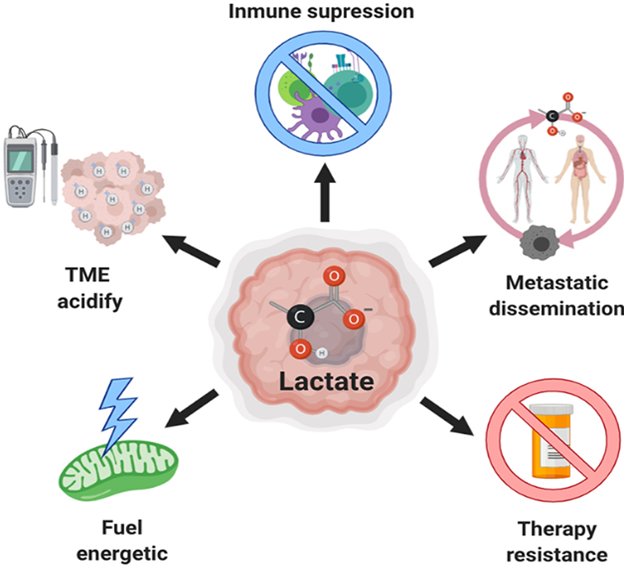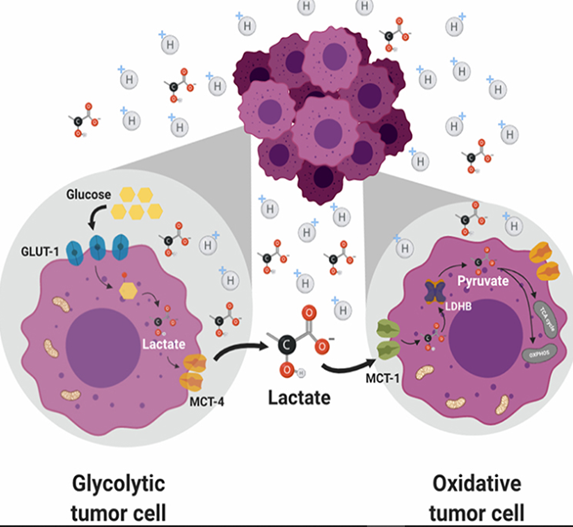Role of Lactate Transport during Glucose Metabolism in Cancer Development
Cancer is a complex disorder that results from multiple abnormalities within the cells and the body. Mostly in cells, cancer results from the overexpression of genes that are encoding proteins of the glycolytic pathway. These cells prefer to produce energy by the glycolysis process instead of oxidative phosphorylation. But glycolysis is a slow process as it produces the least amount of energy in the form of ATP in comparison to OXPHOS.
So, cancer cells need to stimulate this process by utilizing more and more glucose and converting it into energy. These cells take up glucose from the exogenous environment in most cases with the aid of glucose transporters and convert it into pyruvate by glycolysis (Cameron et al., 2018).
Lactic Acid Formation in Cancer Cells
The malignant cells have a very important hallmark which is aerobic glycolysis, and is very crucial for their survival. During this process, cancer cells go through a fermentation process after pyruvate synthesis through glycolysis, even if oxygen is plentiful in the cells.
During this mechanism, these cells convert the pyruvic acid into lactate, and 2ATP molecules are formed. This process is repeated again and again to meet the energy needs of malignant cells and to produce more and more lactic acid.
Role of lactate in the development of cancer
Lactic acid plays a very crucial role in the development and progression of cancer. It is seen in almost all cancer types that the concentration of lactic acid is very high in the tumor microenvironment. It has been observed that the greater the concentration of lactate in the malignant cells of the patient and around these cells, the lesser the survival rate of these patients. It not only helps the malignant cells in their survival but also has an important role in the progression of cancer. It helps the cancer cells metastasize to neighbouring tissues and thus the spread of cancer throughout the body of the patient making his survival difficult. So, we can conclude that lactate plays the following crucial roles during the development of carcinoma:
Acidification of TMELactic acid makes the environment around the tumor cells very acidic. The pH of TME around the malignant cells becomes 6 or 6.5 which is highly acidic. It is best for the enzymes of the extracellular environment to work in the best possible way and help in the survival of cancer cells. This will also help the malignant cells in their invasion as well as in the metastasis to other tissues or organs, making them malignant, too (de la Cruz-López et al., 2019).
- Angiogenesis
Lactic acid has a role in stimulating the formation of more and more blood vessels in malignant cells, thus promoting their angiogenesis.
- Metastasis and Invasion
A very important feature of cancer cells is their movement to the other tissues from the tissue or organ they have originated in. So, lactic acid plays a crucial role in helping cancer cells to metastasize. They can invade the neighboring cells because of the acidic environment around them and spread the tumor phenotype as much as possible.
- Antitumor Immune Response
The immune system of the body responds to cancer cells by reducing their growth and proliferating abilities. But increased lactic acid production by the malignant cells helps them to inhibit the response shown by the immune system against them, and so these cells can easily survive in the body. Thus, lactate has the ability to inhibit the function of the immune system against malignant cells.
- Resistant to Therapy
Many therapies are available against cancers to kill the malignant cells in the body and stop the progression of cancer. Therapeutic modalities such as radiation therapy, immune therapy, chemical therapy, and many targeted therapies are being used to kill cancer cells and improve the survival rates of patients. But the lactic acid produced by the cancer cells by the aerobic glycolytic process makes the cancer cells become resistant to all these therapies. It helps the cells produce energy and repair the damage that is being caused by the use of these therapies.
Usually, the ionizing radiation or the chemicals that are given to cancer patients make DNA double-stranded breaks in the genetic material of the malignant cells in the body, which will not allow the cancer cells to survive anymore. But increased glucose metabolism in the cancer cells helps them produce more energy, and these cells repair these DNA damages making their survival possible. So, lactate has the ability to make the cancer cells develop resistance against the therapies (Sharma et al., 2022).
Lactic acid as an energy source for the malignant cells
Previously, it was thought that lactic acid is just a waste product that is being produced after the process of glycolysis when pyruvic acid is converted to form ATP energy. So, cells utilize the energy for multiple processes occurring in them, and lactic acid is left behind with no important function (Jiang, 2017).
But later, it was observed, while experiments were being performed on the head and neck carcinoma cells in the laboratory, that lactic acid is present in the mitochondrion of the cell and can be converted into fatty acids. It is being used as a source of carbon atoms that are required to synthesize lipids in the mitochondria of cells.
Hence, we can conclude that lactic acid acts as a fuel for cancer cells because it helps them synthesize lipids that provide the cells with energy to perform their many important survival functions.
Experiments have also shown that the lactic acid produced in the cytosol by fermentation or aerobic glycolysis is then moved into the mitochondrion with the help of some monocarboxylate transporter proteins. In the mitochondrion, this lactic acid is oxidized back to pyruvic acid, and then the TCA cycle and electron transport chain starts in the mitochondria. This will lead to the production of an increased amount of energy, as already mentioned that OXPHOS produces more energy as compared to glycolysis.
Hence, lactate can provide fuel to the cells in multiple ways. As in malignant cells, there is increased production of lactic acid, so a large concentration of it will provide the cells with larger amounts of energy that are then used by the cells for multiple purposes such as growth, proliferation, progression of tumors, and to repair the damage caused by therapeutic strategies to these cells.
Also, if the amount of glucose transported into the cancer cells becomes limited, then these cells stop producing lactate, instead, they start utilizing the lactic acid that is already produced. They can utilize it to form lipids, or they can oxidize it to pyruvic acid and go for OXPHOS for the production of energy for their survival (Hirschhaeuser et al., 2011).
Role of Lactate Transport in cancer development
Lactic acid is produced in the cytosol by the process of aerobic glycolysis within the cells. Then it is transported in the exogenous environment of the cell with the help of some specific monocarboxylate transporters, also called MCTs, which are present on the plasma membrane of the cells.
In the case of cancer cells, as mentioned earlier, there is increased production of lactic acid in the cells as cancer cells take up an increased amount of glucose due to their high energy demands for survival purposes and convert this glucose into lactate through pyruvic acid intermediate. So, this high amount of lactic acid is transported out of the cell by means of MCTs in the extracellular environment of the malignant cells which is also called TME. This lactic acid along with protons, when comes to TME, makes the microenvironment very acidic with a pH of around 6 to 6.5.
What happens if lactate is not transported out of the cell? If lactic acid gets accumulated within the cells, it will inhibit a very important enzyme of the glycolytic pathway which is catalyzing the rate-limiting step of this pathway, called phosphofructokinase 1. So, if this enzyme is inhibited, in turn, the process of glycolysis in the cell is inhibited, and the cell will not be able to produce the energy required for its survival. So, the transport of lactate outside the cell is a very crucial phenomenon.
Many types of MCTs are found in the cells that are involved in the transport of lactic acid from inside the cell cytoplasm to the extracellular space. In malignant cells, this lactate transport in the exogenous environment has multiple roles in cancer progression that are already discussed in this article.
Overexpression of MCTs in malignant cells
In many experiments, it has been observed that the monocarboxylate transporters that are involved in the transport of lactic acid are overexpressed in the malignant cells so that more and more lactate is transported out of the cell. As cancer cells produce an increased amount of lactic acid so there is a need for more MCTs in the plasma membranes of these cells. That is why there is overexpression of these transporters in this case (Draoui & Feron, 2011).
Targeting MCTs in cancer
As discussed in this article the transport of lactate out of the cell in TME is very crucial for the survival and progression of cancer. And if this transport is inhibited in the case of malignant cells the accumulation of excess lactate within the cells will lead to cell death.
So, in order to kill the cancer cells and treat cancer patients, MCTs can be targeted by using some specific inhibitors against them to stop the transport of lactate out of the cells. This accumulation of lactate within the cells will kill them and stop the progression of tumors.
References
Cameron, M. E., Yakovenko, A., & Trevino, J. G. (2018). Glucose and Lactate Transport in Pancreatic Cancer: Glycolytic Metabolism Revisited. Journal of Oncology, 2018. https://doi.org/10.1155/2018/6214838
de la Cruz-López, K. G., Castro-Muñoz, L. J., Reyes-Hernández, D. O., García-Carrancá, A., & Manzo-Merino, J. (2019). Lactate in the Regulation of Tumor Microenvironment and Therapeutic Approaches. Frontiers in Oncology, 9(November). https://doi.org/10.3389/fonc.2019.01143
Draoui, N., & Feron, O. (2011). Lactate shuttles at a glance: From physiological paradigms to anti-cancer treatments. DMM Disease Models and Mechanisms, 4(6), 727–732. https://doi.org/10.1242/dmm.007724
Hirschhaeuser, F., Sattler, U. G. A., & Mueller-Klieser, W. (2011). Lactate: A metabolic key player in cancer. Cancer Research, 71(22), 6921–6925. https://doi.org/10.1158/0008-5472.CAN-11-1457
Jiang, B. (2017). Aerobic glycolysis and high level of lactate in cancer metabolism and microenvironment. Genes and Diseases, 4(1), 25–27. https://doi.org/10.1016/j.gendis.2017.02.003
Sharma, D., Singh, M., Gupta, R., Kumar, V., Kumar, V., & Rani, R. (2022). Intervention on lactate in cancer: A promising approach for the development of cancer therapeutics. Advances in Cancer Biology – Metastasis, 5(May), 100058. https://doi.org/10.1016/j.adcanc.2022.100058
Tags: alternative cancer treatments, Blog, cancer, Cancer therapy, cancer treatment, glucose metabolism, metabolism of glucose, Role of Lactate




